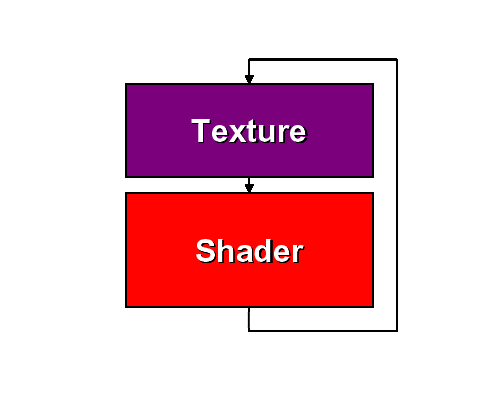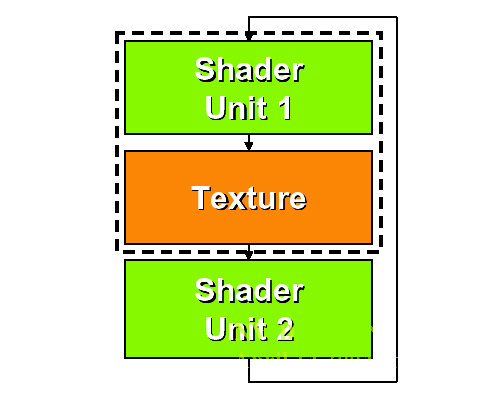What Went Wrong with NV3x: A Moratorium
by Derek Wilson on April 19, 2004 4:12 PM EST- Posted in
- GPUs
Shedding Light On Shader Performance
Explaining where shaders fit in requires a brief explanation of what happens on the whole when rendering 3D graphics on modern hardware. When moving from software to the screen through the graphics pipeline, there are quite a few things that happen, generally moving from the large scale to the small scale. On the top end, objects and geometry are handled. The position and direction of the viewer of the 3D scene, along with 3D positional data are translated, rotated, and otherwise manipulated as necessary very early on. If we were going for a two color wireframe scene, we would be just about finished. As we continue looking down the graphics pipeline, the operations being performed on the scene get more and more finely grained. We start looking not at an entire scene's geometry, but at a surface's normals to help determine how it will be lit. Moving on we texture surfaces, and further still down the line we start looking at the individual pixels being drawn on the screen and what color a particular pixel will be based on all the processing that has happened previously. This is a simplified overview, but generally the further down the pipeline the smaller the scale of the unit being operated on.A side effect of how scenes are processes is that moving down the pipeline, the set of data being worked on grows as the size of the unit being worked on shrinks. For instance, a normal scene will have a bunch of objects in it which are all made up of a bunch of polygons that have 3 or more vertices each. When a scene is finally rendered, we have gone from one scene with some objects to many more polygons, even more vertices, and millions of pixels to worry about. As a side note, all of this means that it is generally more efficient for developers to get as much work done as early in the pipeline as possible.
Shader hardware is a kind of like a fractal of the graphics pipeline as a whole. First, we operate over vertex data, then this data is manipulated and sent down to the pixel pipes where pixel shaders operate per pixel.
Inside the shaders, we are able to perform a vast array of operations on vertices and pixels, and the longer the shader program, the more impact the shader program will have on performance. Another way to look at this is that longer shader programs require more efficient shader hardware to run well.
Just saying "more efficient shaders" doesn't really paint a clear picture of the issue. shader specifications are requiring that parts of the GPU become more and more like a CPU. With this evolution come all the problems and difficulties associated with architecting a powerful CPU. The most interesting aspects of CPU design to look at when trying to understand the reason NV3x fell short of what it could have been: instruction scheduling.
Scheduling is generally viewed as a compiler design issue, but there are plenty of considerations that need to be made from the hardware side. The main issues we will look at that affect scheduling from an NV3x hardware standpoint are: functional unit availability and register pressure.
First, each shader pipeline has a handful of units inside it that can be doing work at any given time. The pixel pipeline of NV3x can handle a texture and a math operation, and in order to keep the pipeline running at full speed, developers need to keep all of these units working at the same time. If instructions in a shader program aren't ordered such that math and texture operations are interleaved, the NVIDIA architecture suffers as half the work that could be getting done won't be getting done. The compiler will do its best to take a program and reorder it so that it interleaves texture and math operations while maintaining the same output in the end. This is a very difficult problem to overcome, but it is also key to NV3x performance. Enabling the compiler back when the 50 series drivers were released was the reason we saw, in some cases, up to a 25% increase in performance essentially "for free".

This is the front end of an NV3x pixel shader pipe.
The next scheduling hurdle is register pressure. Not having enough space to store temporary data in local registers forces a lot of time to be wasted on simply juggling data around. The traditional analogy in computer engineering when dealing with managing registers is Tetris. It's not exactly the same, but it can get just as difficult to optimally fill register space as it can be to optimally drop a block in Tetris without knowing what's coming next. It gets even more difficult when there is less space to do everything in (imagine if the Tetris playing field were even less wide than it already is). This is definitely undesirable as we would like to focus on getting some actual work done rather than just playing hot potato with data. The compiler comes in very handy here as well, and takes care of managing register usage in order to optimize program runtime. Unfortunately, if the hardware isn't well suited to the type of programs being run on it, no compiler will be able to solve all the problems.
The way NVIDIA overcame these issues in NV40 was to revamp the internals of their shader pipelines by adding an extra math unit to all the pixel pipes (pixel shaders can now execute two math instructions at the same time, or a math and texture instruction), and expanding the number of registers available for shader programs to use.

This is the front end of an NV40 pixel shader pipe.
The two math units in the NV40 pixel pipe can be used at the same time when there is no texturing going on, allowing math intensive shader programs to avoid running into scheduling problems, and the registers add more space for easier "bin packing" which alleviates the rest of the large scheduling problems seen in NV3x. In the end, from quadrupling the number of pixel pipes and adding the second math unit, NV40 can push up to 8x the shader performance of NV3x under the right conditions. This very impressive increase in performance was definitely sorely needed as NV3x shader performance was much less than optimal. Vertex shader performance was also essentially doubled in the same manner pixel shader performance was increased up to 8x.
NV40, with its well refined vertex pipes (6) and pixel pipes (16x1) brings a lot of power to the architectural style based in NV3x.










18 Comments
View All Comments
PrinceGaz - Tuesday, April 20, 2004 - link
Maybe they've been saving this article up until after the NV40 was launched? I must admit I subconciously substituted postmortem myself when reading it.Well put together article Derek, it clearly explains some of the problems that led to the entire GeForce FX (NV3x) range of cards always being in second-place behind equivalent R3xx cards (the NV34 core FX5200 had no R3xx based competitor).
I'm surprised no mention was made of the FP16/FP32 performance issue with the NV3x core and the consequences that is having on image quality, and also how its inferior ordered-grid anti-aliasing couldn't compare with the rotated-grid used in the R3xx.
Phiro - Tuesday, April 20, 2004 - link
wahahahaa a "moratorium" hahahaYou guys need to quit looking up big words that sound like the word you really mean to use, and actually grow some vocabulary.
How about "postmortem"? Do you even know what the word "moratorium" means?
Cybercat - Tuesday, April 20, 2004 - link
Nice work, you made it user friendly, so even I can understand it! lol, when it comes to explaining graphics architectures to me, that's no small feat.newuser12 - Monday, April 19, 2004 - link
this article is depressing, being as I have an mx-440....... :(ZobarStyl - Monday, April 19, 2004 - link
By this hardware I meant the x800 sorry.ZobarStyl - Monday, April 19, 2004 - link
Thank you, Derek, for politely avoiding going into the current speculation war about the new hardware...frankly no one but ATI knows how this hardware is going to hold up against the 6800, and it's sad that people on both sides have already pronounced winners and losers. A good article; it sheds light on these dark times for nVidia. I'm no fanboy...frankly I'm most swayed by their quality driver support rather than the sheer speed factor.Modal - Monday, April 19, 2004 - link
Thanks for this elucidating article; I find articles of this type (that is "this is what your hardware is doing and why") very interesting.Regs - Monday, April 19, 2004 - link
lol. I just find it funny you wait until now to write this article. But then again, you would likely have a better understanding when we could compare it to the NV40.